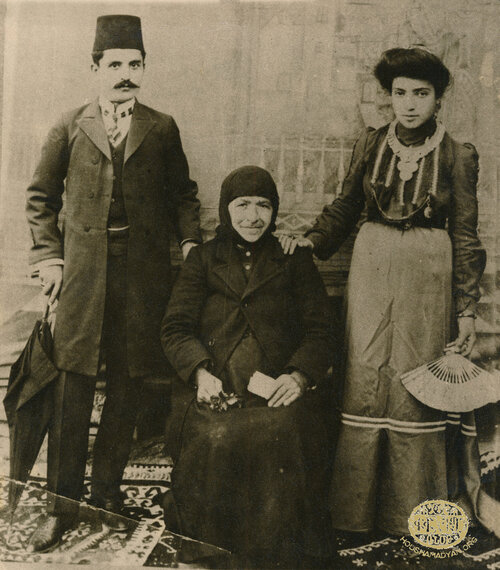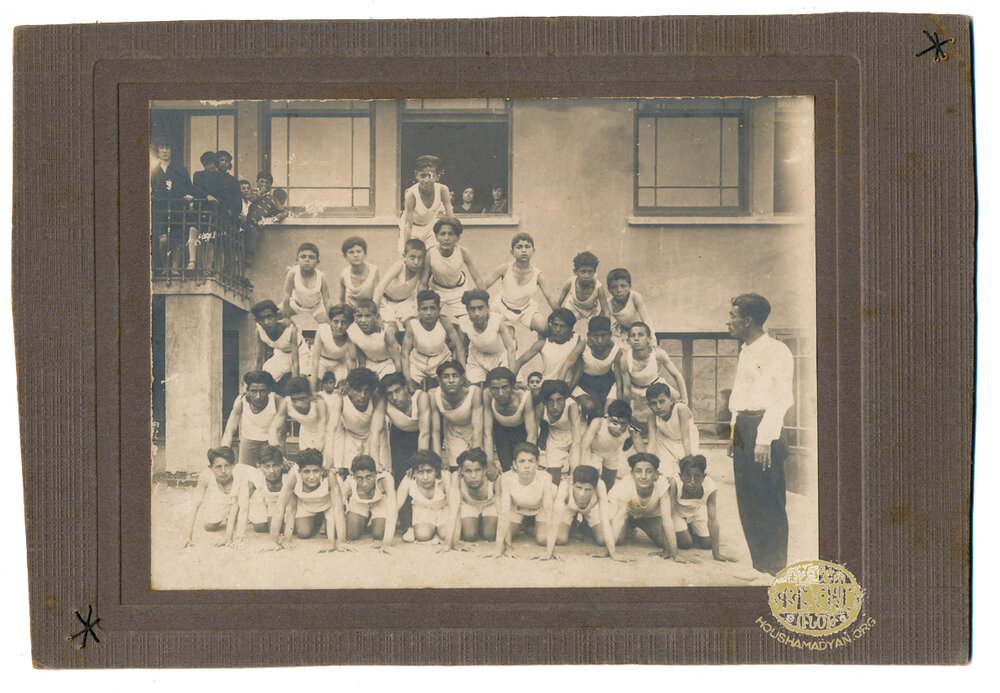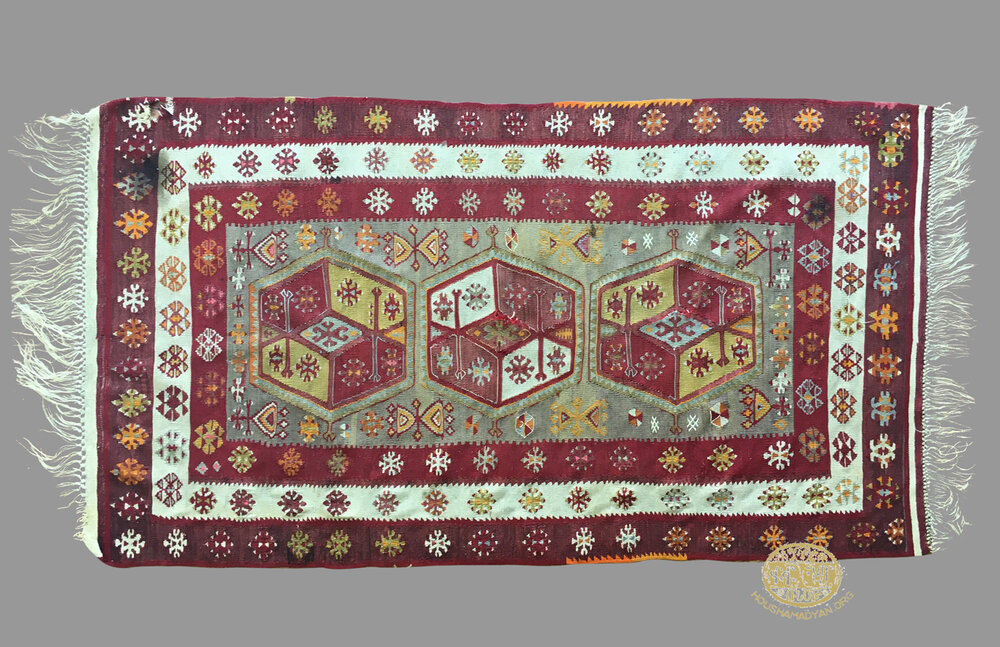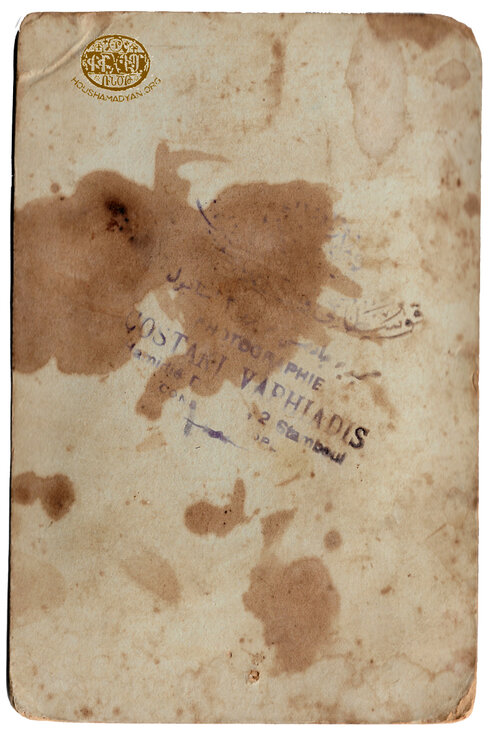Krikor Geukjian Collection – Beirut, Lebanon
Author: Krikor Geukjian (Last modified 06/04/21)

The material presented on this page was provided to us by Krikor Geukjian (from Lebanon). It consists of the collections of the Geukjian and Kasbarian families. These two families were related by marriage and had their roots in Keskin Maden, Gürün/Gurin, and Kershehir/Kırşehir.
All items included in the collection are family heirlooms and are currently kept in Lebanon.
Throughout the page, you will see different spellings and versions of the families’ surnames (Geuyjian, Geukjian, Gökce, etc.). Different members of the families used different versions at different times and in different places.
Krikor Geuyjian was the father of Sarkis and Simon. Krikor was born in Gurin, but later moved to Keskin Maden (present-day Kirikkale/Kırıkkale). He most probably made the move after the massacres of 1895 that took place during the reign of Sultan Abdul Hamid. Sarkis and Simon were both born in Maden. The family surname, Geuyjian, later evolved into Gökce in Turkey and Geukjian in Lebanon.
Krikor Geukjian inherited these photographs from his ancestors. He also inherited his name from his grandfather, Krikor Geuyjian. We also know that Krikor, the family’s patriarch, had a sister named Isgouhi. She lost her husband during the Genocide but survived alongside her two children, a son named Harutune and a daughter named Anna.


The Geukjian/Geuyjian and Antikadjian Branches of the Family
Krikor Geuyjian lived and worked in Keskin Maden, where he was a well-known tailor. In the photograph taken in his workshop, we see that he employed six workers in his business. The family’s involvement in the textile trade endured for three generations. Krikor’s older son, Simon, himself became a famous tailor in Istanbul, while Simon’s two sons, Krikor and Hagop, owned a factory that manufactured cotton and wool apparel. Krikor Geuyjian’s younger son, Sarkis (Simon’s brother), was engaged in the trade in threads and yarns first in Istanbul and later in Beirut, where his son, Krikor, continues to run the family business today.
Zabel Antikadjian was Krikor Geuyjian’s wife. The Antikadjian family had its roots in Gurin, but they had settled down in Keskin Maden before the Genocide. Taniel Antikadjian was married to Gulizar (maiden name unknown), and they had seven children (four daughters and three sons). The daughters were named Zabel, Dikranouhie, Marie, and Araxie; and the sons were named Levon, Manoug, and Souren. Souren was the youngest of the couple’s children, born in the same year as his nephew Sarkis, Zabel’s son. According to the information we have, Taniel was the owner of a public bathhouse (hamam) in Keskin Maden, which he managed successfully.
Krikor Geuyjian and Zabel Antikadjian were married in Keskin Maden most probably around 1910. They had two sons: Simon, born in 1913; and Sarkis, born in 1914. They also had a daughter who died at an early age.
During the Armenian Genocide (1915), all male members of the Geuyjian and Antikadjian families were executed by Turkish gendarmes in front of the rest of the family. The women and children survived thanks to the intervention of their influential Turkish neighbors, namely Mehmet Agha and his brother Cam Göz Mustafa/Djam Goez Moustafa. After the First World War, these same Turkish neighbors advised Gulizar Antikadjian to take her sons and “beautiful” daughters and move to Istanbul. By that time, no Armenians remained in Keskin Maden, and the family would not allow to marry its members with Turks.
The family took this advice and decided to move to Istanbul. We do not know the exact number of family members who left their homes in Keskin Maden around 1920 and made the journey to Istanbul; we only know that the group consisted solely of women and children, carrying only their essential belongings with them. They were well-aware that they were leaving their homes without any hope of ever returning. Their journey to Istanbul was a terrible ordeal. They traveled on foot, and due to the great strain that she suffered, Gulizar was unable to bear the continuous crying of her youngest child, Souren. She left him under a tree and continued her journey. But some time later, she regretted her action, turned back, and retrieved Souren.

Life in Istanbul after World War I
Once in Istanbul, the Geuyjians and the Antikadjians rented one or two rooms in a khan (a popular, cheap inn used by travelers). The women started to work in the homes of wealthy families as cooks, dishwashers, or laundrywomen.
As Simon, Sarkis, and Souren grew up, they found small jobs to contribute to the income of their families. Simon and Souren apprenticed with tailors, while Sarkis sold haberdashery as a street peddler. After a while, Sarkis found work with an Armenian metal trader. The boys couldn’t get proper education due to their dire economic situation. Only Sarkis was lucky enough to attend the Bezjian School in Istanbul and obtain his primary school diploma. Based on his records and teachers’ evaluations, he was a bright student and a prize-winning athlete.
These three orphaned boys, now adults, began establishing themselves bit by bit in their respective fields thanks to their perseverance and hard work. However, things changed radically in May 1941 when the government issued an order, known as 20 Kura Askerlik (“The Twenty Classes”), requiring the military conscription of all non-Turkish men between the ages of 20 and 40. These men were forced to work in road construction and on the railroads in faraway corners of the country under terrible conditions. Simon, Sarkis, and Souren were all forced to serve in these infamous Amele Taburus (Labor Battalions).
No sooner had they returned from forced labor that a new governmental decree was issued in November 1942, known as the Varlik Vergisi (Wealth Tax). This was a tax levied on the non-Muslim citizens of Turkey with the stated aim of raising funds for the country’s defense budget. In fact, the law aimed to destroy the economic power of the county’s minorities (in other words, to Turkify the economy). Somehow, Simon, Sarkis, and Souren managed to pay the heavy taxes levied on them, thus avoiding the labor camps in distant Erzurum that were the final destination of the nonpayers. After this, a period of relative calm and leniency followed, during which the three brothers separately established their own businesses – Simon opened a tailor’s workshop; Sarkis opened a thread and yarn shop; and Souren, together with his brother in-law, Meroujan Hashimian, opened a silverware shop.
1. Istanbul. Left to right: Ovsanna Eker (Souren’s niece and Sarkis’s cousin), Souren Antikadjian, and Sarkis Geukjian.
2. Istanbul, circa 1930. Standing, left to right: Sarkis Geukjian and Simon Geukjian. Seated, left to right: Araxie Antikadjian and Zabel Geukjian (nee Antikadjian).
3. Sarkis Geukdjian was born in 1914. We do not know how old he was when he began attending the Bezdjian School in Istanbul, but we know that he graduated from the school at the age of 17. He was probably 15 or 16 years old when this photograph was taken in Istanbul. He is seen with his art class project: a small decorative cupboard crafted with plywood cut-outs. Called a decoupage, this was a common art class project into the 1960s.
4. Sarkis Geukjian in Turkish military uniform, photographed during his military service in Adapazar. The inscription on the back of the photograph reads “7.9.1941, Turkey.”

The Kasbarian Branch of the Family
We now turn to the maternal side of Krikor Geukjian’s family. Kasbar Kasbarian was born in Gurin around 1880. He was married to Anna Geuyjian, also born in Gurin. For unknown reasons, the couple moved to Kershehir/Kırşehir (a town located between Ankara and Kayseri), where Kasbar made his living in the mohair yarn trade. As can be seen here, Anna was Krikor Geuyjian’s first cousin. Kasbar and Anna married around 1910 and had ten children, two of whom died at an early age. Their six daughters, in descending order of age, were named Arpine, Meline, Armine, Arsine, Hermine, and Mavline. Their sons were named Garabed and Hampartsoum. All the couple’s children were born in Kershehir.
The boys and the youngest girls were received a limited education in their neighborhood school. Only Hermine and Hampartsoum continued their education after the family’s move to Istanbul. Kasbar survived the Genocide thanks to his conscription in the Ottoman army. The rest of the family was authorized to remain in Kershehir throughout the First World War because the head of the family served in the army.
After the return of Kasbar from the front, as no Armenians were left in the town or its vicinity, the family decided to move to Istanbul. Based on the date written on the back of family photographs, we can assume that the Kasbarians moved to Istanbul around 1939.

The Kasbarian and the Geuyjian Families in Istanbul
In Istanbul, the oldest girls of the Kasbarian family, Meline and Armine, together with Garabed, opened a workshop making tailor-made shirts. Garabed also opened another shop selling sewing machines. Hermine and Hampartsoum, after completing their secondary education, were admitted to Istanbul University, from which Hampartsoum graduated as a medical doctor. As for Hermine, after studying pharmacy for one year, she married Sarkis Geukjian in 1947.
Hermine and Sarkis’s first child, Krikor, was born in 1948. Their second child, Vartouhi, was born in 1952. During these years, Sarkis’s business prospered, and he invested in real estate in order to secure his future.
However, periods of political calm and tranquility do not usually last long in Turkey. As the year 1955 approached, the Cyprus Question became the predominant political issue in the county. The night of 6 to 7 September 1955, known in Turkish as 6-7 Eylul Olaylari, would be another black page in the history of the country’s minorities. Turkish mobs brought to Istanbul from distant corners of the country, launched a wave of pre-planned carnage in Istanbul, looting and destroying the property of not only Rum/Greek citizens (because of the Cyprus Question), but also the city’s Armenians and Jews. The purpose of the pogrom was to annihilate, once and for all, the economic power still in the hands of minorities, and to secure the dominance of ethnic Turks. As a result, thousands of minority families left Turkey for good, seeking security and stability in other countries. Sarkis’s shop was one of the thousands throughout the city that were looted and gutted. On his way to the shop, the next morning, he came across his merchandise littering the streets of the neighborhood.
These events were a wake-up call for Sarkis, who became convinced that he and his family could no longer live peacefully in Turkey. So, he decided to leave as soon as possible and began liquidating his belongings. He was able to do so in record time by selling everything he owned at reduced value. When his friends advised him not to rush, he replied, “I don’t want to have a single tie to this country.” In the meantime, his brother Simon and his uncle Souren continued to live and work, with their families, in Istanbul.

Standing, back row, left to right: Sarkis Geukjian and Simon Gökçe. Front row, left to right: Hagop Gökçe, Herminé Geukjian, Krikor Geukjian, Zabel Gökçe, Sirarpi Gökçe, and Vartouhi Geukjian.

A New Life in Lebanon
In December 1956, Sarkis was the first of his family to leave Turkey for Lebanon. His wife and children joined him there a few days later. They traveled separately as a precautionary measure, seeking to avoid the attention of the Turkish government, which was closely monitoring the movements of minorities. Additionally, among other restrictions, the authorities had forbidden non-Turks from leaving the country with more than 100 Turkish liras. Lebanon was chosen as a jumping-off point, from which the family hoped to proceed to Canada or the United States. Once the Geukjian family had found its footing in Lebanon, members of the Kasbarian family joined them there one after another.
The family’s attempts to emigrate to Canada or the United States failed, and they eventually decide to settle down for good in Lebanon and start a new life from scratch.
In 1957, Sarkis opened his own thread and yarn shop in central Beirut. The shop is still in business today under the management of his son, Krikor Geukjian. Krikor was the only member of the family who ever learned Arabic (at school), and thus served as a translator for the entire family. The others could only speak Armenian and Turkish.
Almost a year after the family’s arrival in Lebanon, the country became the theater of a conflict that pitted Arab nationalists against militants who supported the Lebanese president, also supported by the United States. The clashes of 1958 revealed the fragility of the county’s Armenian community, and its inability to cope with extraordinary political situations of this kind. Two rival Armenian camps emerged: on the one hand, the Armenian Revolutionary Federation (ARF; Dashnak Party), allied with the pro-Western Lebanese president; and, on the other, the Social Democrat Hunchakian (Hunchak) Party and Communists, allied with the Arab nationalists. These two groups engaged in armed clashes, and the intracommunal fighting spread rapidly. This was a bitter welcome for the Geukjian and Kasbarian families. Their friends commiserated by saying, “you escaped the rain just to get caught in the hail.”
Many Armenians who had fled Turkey and sought refuge in Lebanon, where they hoped to find safety, were appalled and disappointed by the fratricide they had witnessed, which was unfathomable for them. For this reason, many newcomers left Lebanon for good, but the Geukjian and Kasbarian families stayed.
From 1958 on, political crises and upheavals have continued to beset Lebanon, down to the present day. However, the Lebanese-Armenian community has never been collectively targeted and attacked merely for its ethnicity. For instance, once they had moved to Lebanon, the Geukjians never again heard the word gyavur (or its Arabic equivalent),meaning “unbeliever” or “infidel” in Turkish, and commonly used in Turkey as an insult hurled at non-Muslims.
In the late 1980s, Krikor Geukjian met Annie Paloulian, a French language teacher working at the Nishan Palandjian Djemaran (Lyceum) in Beirut. Her ancestors hailed from Arapgir. The two were married in 1987 and have three daughters: Arpy, Talar, and Garine.



Additional Photographs
Below are additional photographs from the family collection. They feature individuals who could not be identified, presumably relatives and friends.









































